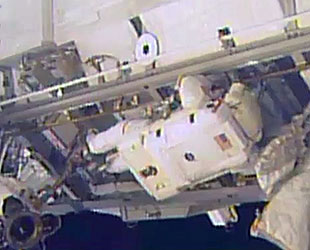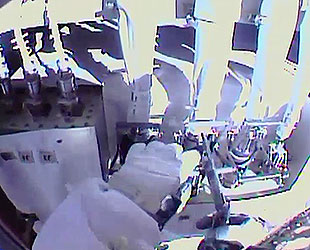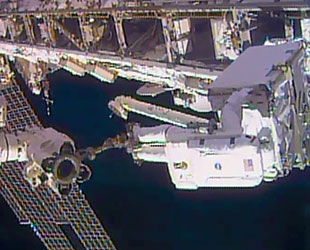UPDATE (Dec. 21) – Following the successful completion of Saturday's spacewalk, NASA delayed the next planned excursion from Monday to Tuesday morning (Dec. 24).
The extra day will allow time to resize a backup spacesuit for astronaut Rick Mastracchio. During repressurization of the station's airlock following Saturday's spacewalk, a suit configuration issue put the suit he was wearing in question for the next outing.
Astronaut Koichi Wakata reported the issue to the ground during the airlock's repressurization.
"[Mastracchio] inadvertently moved the water switch [on his suit] to on and it was quickly returned to off," Wakata told Mission Control.
During a later call up to the station's crew, flight controllers expressed concern about the "water in the sumblimator" in Mastracchio's suit, and sent up procedures to dry it out.
According to NASA, this issue is not related to the helmet water leak that cut short a spacewalk in July.
Due to the slip, if a third spacewalk is needed to complete the repair of the space station's cooling system, it will now take place no sooner than Dec. 26, rather than Christmas Day, as originally scheduled and reported below.
December 21, 2013– Astronauts working speedily outside the International Space Station removed a malfunctioning pump module ahead of schedule, potentially ruling out the need for a Christmas Day spacewalk to continue repairs to the orbiting outpost's critical cooling system.
Expedition 38 flight engineers Rick Mastracchio and Mike Hopkins ventured outside of the station at 6:01 a.m. CST (1101 GMT) Saturday (Dec. 21), just ten days after a flow control
valve ceased working properly inside the ammonia pump module they were set to remove and replace during another six-and-a-half-hour spacewalk on Monday.
Saturday's spacewalk came to its end at 11:29 a.m. CST (1729 GMT), five hours and 28 minutes after it began.
Originally, Mastracchio and Hopkins were going to prepare the faulty pump for removal today, but the spacewalkers completed the majority of the planned tasks for Saturday's spacewalk in just three hours. The astronauts were then given a go by Mission Control in Houston to press ahead with removing the refrigerator-size pump module and stow it on a nearby platform.
"We're about an hour and a half ahead of the timeline, so, choosing your own adventure we're going to go ahead and look forward to doing the pump module exit," capcom and astronaut Doug Wheelock advised from Mission Control.
Quick disconnects
The pump module's early removal could mean that a third
spacewalk planned for Dec. 25 may not be needed.
The faulty control valve, which regulates the temperature of the ammonia flowing through the pump, ceased working properly Dec. 11. Non-critical systems and experiments in two of the station's laboratories have been powered down since.
Saturday's spacewalk was originally to be focused only on disconnecting the fluid lines from the failed pump module and installing a "jumper" box to prevent the ammonia from over pressurizing during the pump's replacement.

Rick Mastracchio works to disconnect and replace a faulty pump module outside the International Space Station. (NASA TV) |
Working along the starboard, or right, side of the station's backbone truss, Mastracchio (riding on the space station's robotic arm) and Hopkins first set about de-mating "quick disconnect" fluid lines from the faulty pump.
As their name implies, the quick disconnects are intended to be plugged in and out, but past spacewalks, including an August 2010 outing to replace the same pump module, ran into trouble unplugging the pressurized lines. Learning from prior experiences, the pressure in the fluid lines was reduced in preparation for Saturday's spacewalk.
As such, Mastracchio and Hopkins disconnected the fluid lines with little trouble. The first of the lines was unplugged an hour and 45 minutes into the spacewalk.
Some 'snow'
As the lines were loosened though, the two spacewalkers did report seeing "snow," small flakes of frozen ammonia, floating from the ends of the connectors.
"I do see some snow, very little," Masstrachio said. "Very small flakes coming from the forward side of the QDs. Very small flakes."
Mastracchio, responding to Mission Control, confirmed the flakes may have landed on his and Hopkins' suits. One of the dangers associated with working with the ammonia is the chance of contamination, though the small solid flakes were not of great concern.

"Helmet-cam" view showing Rick Mastracchio's vantage point as he works to disconnect fluid lines on a pump module. (NASA TV) |
With the first two lines released from the pump module, Mastracchio and Hopkins next worked to connect them to a "jumper" box, which routes the ammonia back into the coolant loop to maintain it in a liquid phase. That task was followed by disconnecting the remaining two fluid lines and five electrical lines from the pump module to be replaced.
"Very nice, came out beautifully," Masstracchio remarked, commenting on the release of one of the lines. "Almost no loads on that thing at all, came off very cleanly."
Cold feet toes
It was the ease in which the lines were disconnected that allowed time for the pump module's removal. Mastracchio had only one note of concern for the added work: his toes.
"The only issue I personally am having is it is very, very cold," Mastracchio said. "Because I'm just floating here on the [robotic] arm, I have got very, very good air flow in my boots but my toes are quite cold."

Astronaut Rick Mastracchio supports a faulty pump module as he rides on the end of the space station's robotic arm. (NASA TV) |
To remove the 780-pound (355 kg) pump module, the four bolts holding the module in place needed to be released. Mastracchio, still riding on the arm, then pulled the bulky pump out of the station's truss part of the way so Hopkins could install a robotic arm grapple fixture on its side.
Working from inside the space station, Japan Aerospace Exploration Agency (JAXA) astronaut Koichi Wakata then controlled the arm to "fly" Mastracchio, holding the pump module, to the pump's temporary storage point, called the Payload ORU (orbital replacement unit) Accommodations, or the POA.
At the beginning of the spacewalk, Hopkins had also been scheduled to prepare the replacement pump module to be installed on Monday, but after checking with Mastracchio, Mission Control agreed to end the outing after the removal of the faulty pump module was completed.
Snorkels in spacesuits
Saturday's extravehicular activity (EVA or spacewalk) was the first with U.S. EMU spacesuits since July, when water flooded into astronaut Luca Parmitano's helmet. Hopkins wore Parmitano's spacesuit but with a new filter assembly, replacing the faulty component.
As a precaution, NASA engineers had both Hopkins and Mastracchio outfit their suits with helmet
absorption pads and makeshift snorkels, but they weren't needed. The two astronauts' helmets stayed water-free throughout, as they confirmed during periodic checks.
This was Mastracchio's seventh spacewalk and Hopkins' first. Overall, it was the the 175th spacewalk in support of the assembly and maintenance of the International Space Station.
Monday's spacewalk will pick up where Saturday's outing ended, with Mastracchio and Hopkins installing the spare module. Depending on how far they get with the module's connections Monday, a Christmas day outing to reconnect the fluid lines and stow the old pump module for possible future repair may not be necessary.
